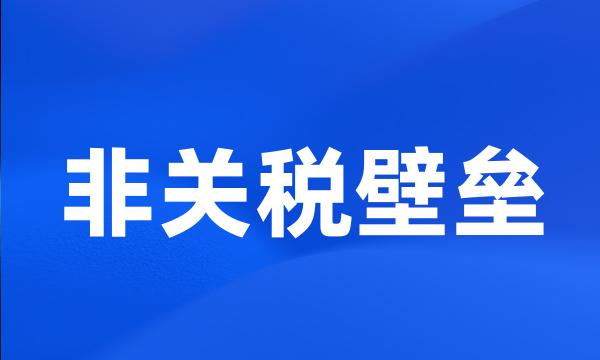非关税壁垒
- non-tariff barrier
 非关税壁垒
非关税壁垒-
尤其是我国加入WTO后,纺织品服装出口必将面临进口市场非关税壁垒的种种限制。
Our export of textiles and garments will face with the limit of non-tariff barrier especially after we enter into WTO .
-
世界贸易组织(WTO)致力于通过多边贸易谈判使各成员方不断降低关税,取消非关税壁垒,实现贸易自由化。
The World Trade Organization ( the WTO ) is dedicated to reduce tariff , cancel non-tariff barrier and realize trade liberalization by multilateral trade negotiation .
-
它是WTO法律框架中非关税壁垒的多边协定中的一部分。
It is a part of the multilateral agreement of non - tariff wall in WTO law frame .
-
各经济体还将消除各种非关税壁垒,包括扭曲环境产品与服务贸易的地方成分要求(见附件C)。
Economies will also eliminate non-tariff barriers , including local content requirements that distort environmental goods and services trade ( see Annex C ) .
-
中国加入WTO后,随着关税削减和非关税壁垒的取消,进口需求得以释放,进口将有大的增加。
After China 's entrance to the WTO , with the decrease of tariff and non-tariff , the import will increase greatly .
-
谷歌(Google)威胁退出中国,令此前的无声抱怨公开化,这些抱怨是围绕非关税壁垒和有专横之嫌的监管。
Google 's threat to quit China has brought into the open previously muted complaints about non-tariff barriers and allegedly arbitrary regulation .
-
作为WTO规则所允许的贸易救济手段,反倾销措施正发挥着以往关税和非关税壁垒的作用。
Anti-dumping measure , as trade relief means that WTO rule allows , is playing a role of tariff and non-tariff wall in the past .
-
曼德尔森担心,在中国完全加入世界贸易组织(wto)后,中国会越来越多地使用非关税壁垒来管理进口。
Mr Mandelson is concerned at the increasing use of non-tariff barriers by China to manage imports following its full accession to the World Trade Organisation .
-
我国安全事故频发,加入WTO和经济全球化迫使我国必须重视职业安全健康非关税壁垒。
The safety fact that many accidents happened these years and our countries coming into WTO compels us to recognize the importance of occupational safety and health .
-
WTO《贸易技术壁垒协议》作为非关税壁垒的主要方面,制定了一些较严格的技术法规和技术标准。
WTO 'S Agreement on Trade and Technology Barriers , as an important aspect of the non-tariff barriers , lays down some strict technological regulations and standards .
-
随着经济全球化进程和WTO的成立,全球关税水平逐步降低,传统非关税壁垒也日益减少。
With the establishment of WTO and process of economic globalization the general global tariff rates have been getting down and traditional non-tariff trade barriers becoming less .
-
世界银行(worldbank)经济学家估计,非关税壁垒,包括补贴、价格管制措施及技术标准等其它造成市场扭曲的手段,占到全球所有贸易壁垒的70%。
According to estimates by World Bank economists , non-tariff barriers , including other distortions such as subsidies , price control measures and technical standards , make up 70 per cent of all global barriers to trade .
-
随着贸易自由化进程的加快,各种关税和非关税壁垒措施逐渐为WTO所限用或禁用。
With the rapid development of trade liberalization all over the world , various tariff and non-tariff measures used as trade barriers have been restricted or totally forbidden by WTO .
-
另一方面,入世意味着减少关税和非关税壁垒,从而使WTO成员国之间资源配置更大程度体现它们各自要素禀赋和比较优势结构。
On the other hand entry into WTO means reduce tariff and tariff wall . This will make the resources scheme incarnate embody the factor gift and the frame of compare advantage .
-
中国在加入WTO谈判过程中涉及汽车产品的相关承诺包括关税的降低、非关税壁垒的放开、国内汽车服务贸易领域允许外资进入等方面将逐步兑现。
The commitment which is involved during the WTO negotiation includes : tariff cut , openness of non-tariff barrier , the permission of the foreign capital into the domestic automobile service sector .
-
加入WTO以后,关税壁垒以及传统的非关税壁垒不断降低或拆除,为我国的农产品出口带来了新的机遇。
After china joined WTO , the trade restricts brought by the tariff barriers and non-tariff barriers are decreased so that it 's a good chance to develop the exportation of farm products .
-
在加入WTO谈判中,我国承诺扩大农产品市场开放程度,降低关税,逐步取消非关税壁垒和粮食出口补贴等。
In the negotiation of joining WTO , China promised to enlarge the market of farm products , reduce the tariff and cancel non-tariff barrier and allowance of foodstuff export step by step .
-
由于随乌拉圭回合的谈判结束和WTO的成立,关税壁垒受到大幅削减,非关税壁垒逐渐成为贸易保护主义的主要措施,而尤以技术性贸易壁垒为甚。
As with the " Uruguay Round " of WTO negotiations end and the establishment of tariff barriers substantially reduced , non-tariff barriers gradually become the main measures of trade protectionism , especially technical barriers to trade .
-
随着中国加入WTO以及纺织品配额的取消,绿色贸易壁垒这一非关税壁垒逐渐成为发达国家对我国纺织品出口设置的主要贸易障碍。
With China 's entry into WTO and abolishment of textile quota , green trade barrier , the non-tariff barrier , has growing into a main trade barrier which developed countries throw in export of China 's textiles .
-
在贸易自由与市场准入涉及的关税和非关税壁垒问题成功纳入WTO体制后,新的、更深层次的问题又产生了,即企业阻碍贸易自由发展的反竞争行为。
After admitting the tariff and non-tariff issues on trade freedom and market entrance into the WTO framework , the new and more deep-seated issue arises , i.e. the firm 's anti-competition act hindering the development of free trade .
-
我国应该积极发展与其他国家的双边或多边FTA,绕开非关税壁垒,扩大出口,促进经济发展。
China should actively develop bilateral and multilateral FTAs with other countries and steer clear of nontariff barriers , so as to expand export and promote economic development .
-
中国加入WTO在纺织方面做出了种种承诺,虽然加入WTO以后,有关关税和配额方面的限制越来越少,但是其他非关税壁垒措施依旧存在,且越演越烈。
China makes the promise about textile industry . After entry into WTO , the restriction about tariffs and quotas is becoming less and less , but other non-tariff barriers still exist , and then become more and more intense .
-
随着经济全球化的发展,WTO的建立和运行,关税降低和传统的非关税壁垒的逐步消除,贸易自由化向纵深方向发展。
With the globalization of world market and the operation of the WTO , tariff duties have been successfully lowered and the traditional non-tariff barriers have been progressively removed , which symbolized the further liberalization of world trade and investment .
-
加入WTO以后,我国农产品在国际贸易中的最大障碍将不再是关税及传统的非关税壁垒,而是部分国家和地区为保护自身利益而设置的绿色壁垒。
After the access to the WTO , the most barrier is other than the traditional barriers in tariffs and non-tariffs but the Green-barrier set up by some countries ( or area ) for protection of its own trade benefits .
-
许多跨国公司为发展中国家设置出一道比单纯TBT或知识产权壁垒更高、更难对付的非关税壁垒&技术标准壁垒。
Many multinational companies setting up the technical standards that more higher and more formidable non-tariff barriers than TBT or intellectual property barriers for developing countries .
-
随着中国纺织服装行业步入后配额时代,企业社会责任SA8000等非关税壁垒对中国纺织行业的影响越来越大。
The non-tariff wall such as social accountability 8000 has more and more effect to China 's textile and apparel industry in post-quota age .
-
加入WTO后,国家为汽车产业所筑起的关税和非关税壁垒将很快消失,中国汽车产业将面临全球化的竞争环境。
After entering into WTO , the tariff and non - tariff barriers that Chinese government has set up to protect the automobile industry will disappear rapidly . The automobile industry in China will face up to the global competitive environment .
-
加入WTO后,我国石油、石化经营环境主要有三个方面的变化,即减让关税、取消非关税壁垒和逐步放开分销服务。
The business environment for China 's petroleum and petrochemical industries will witness three major . changes after the country joins WTO , namely a reduction of tariffs , the abolishment of non-tariff barriers and the gradual opening of the distribution network .
-
与此同时,欧美各国利用各种非关税壁垒特别是近期推行的SA8000对我国企业提出了严峻的挑战。
At the same time , it challenges our enterprises that the none-trade barrier especially for SA8000 that was carried out by European and American countries .
-
SA8000和反倾销是西方国家对我国国际贸易的两大非关税壁垒,这两种机制对我国经济发展存在多方面的负面影响。
SA8000 and anti-dumping are two major non-tariff barriers for China in the international trade with western countries , which have negative impact for the economic development of China .
